
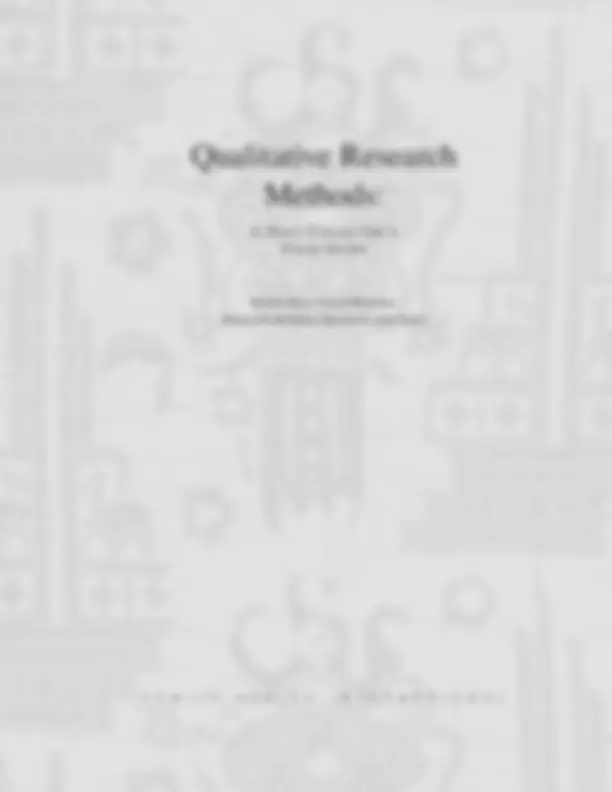


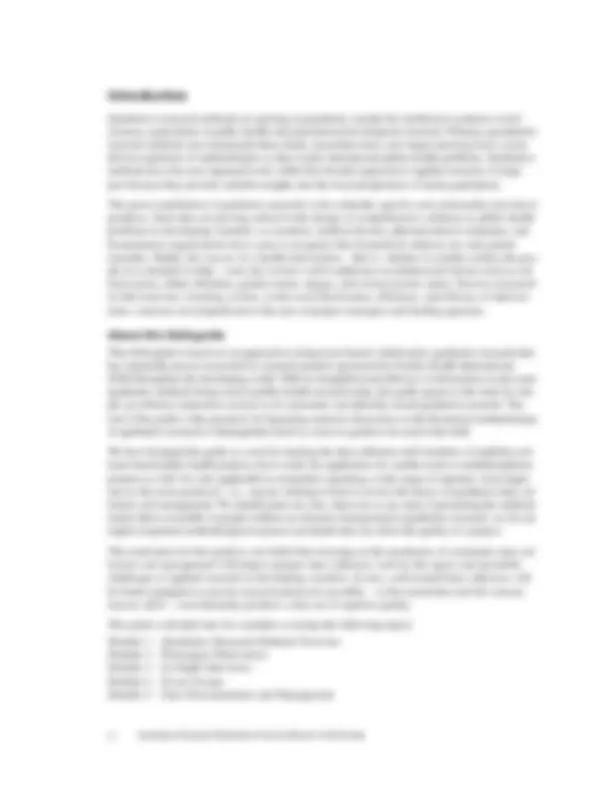
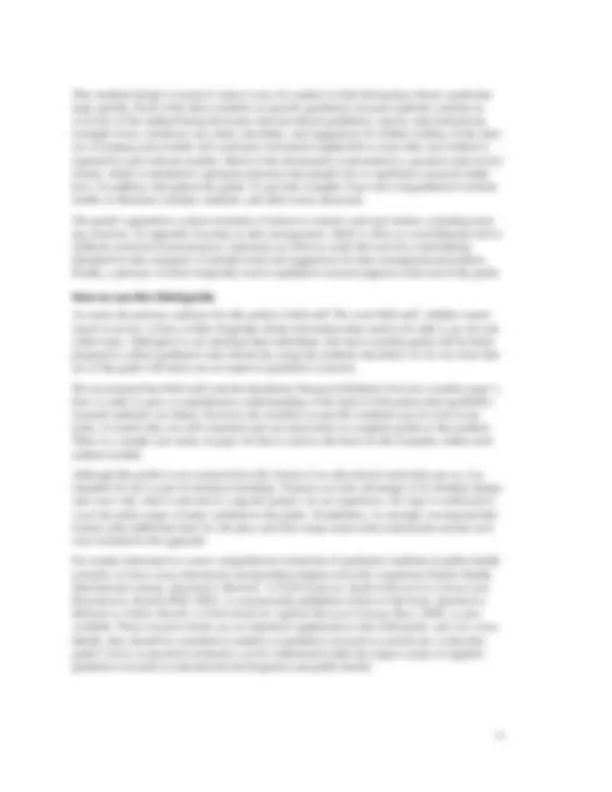
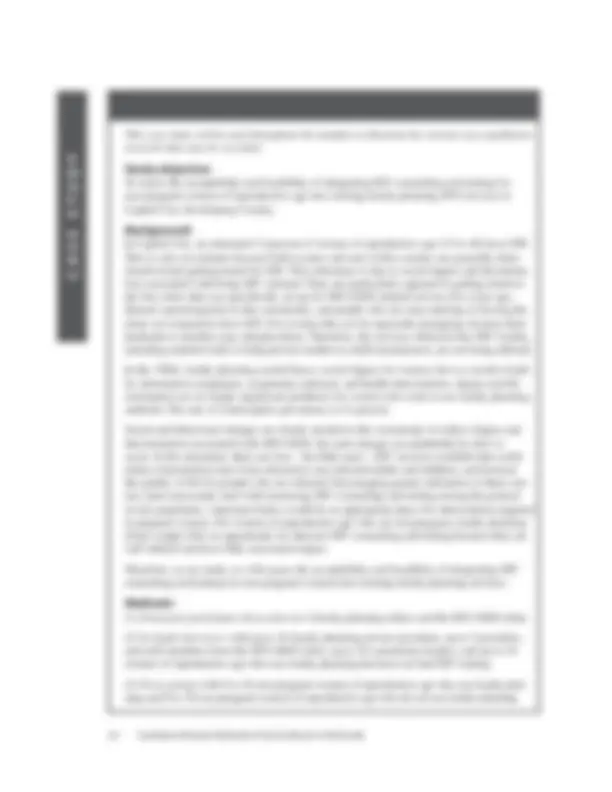
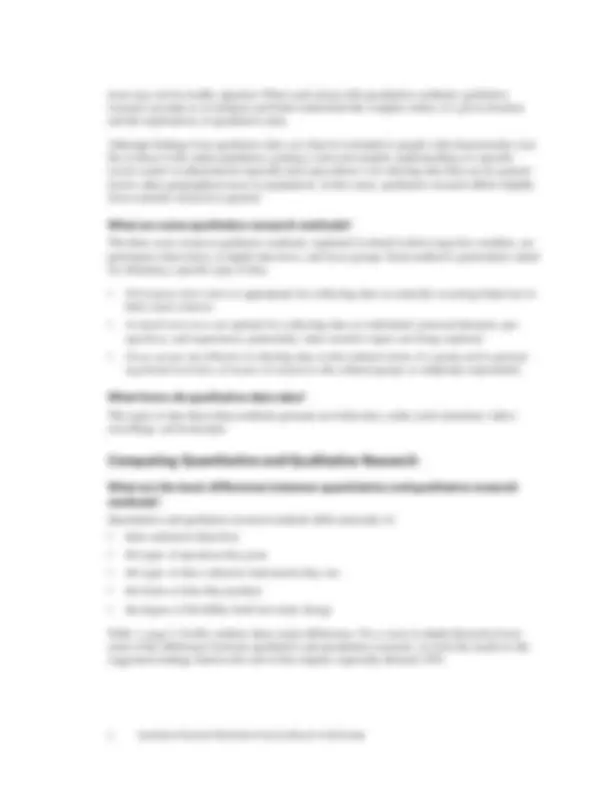



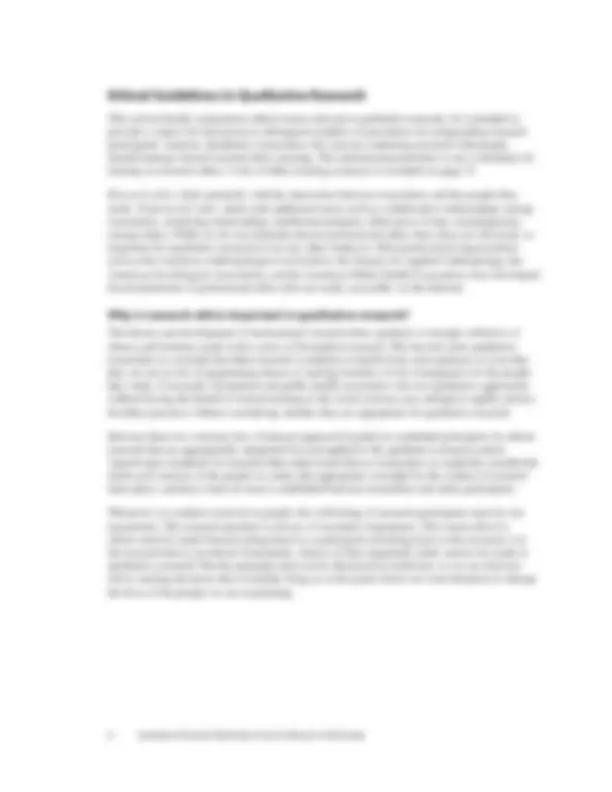

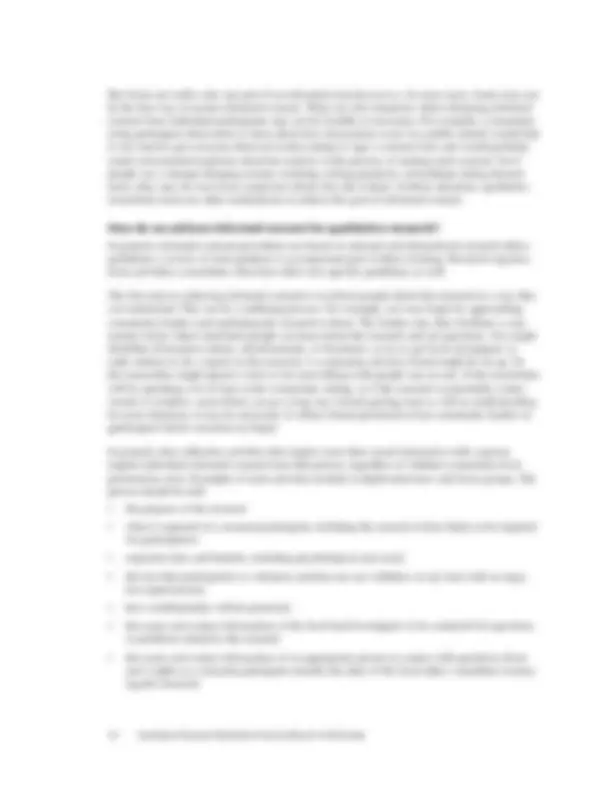

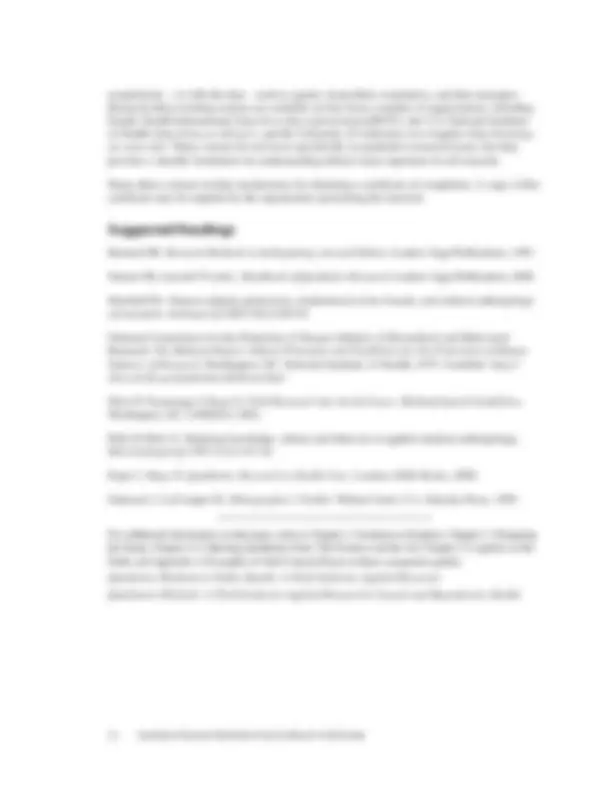

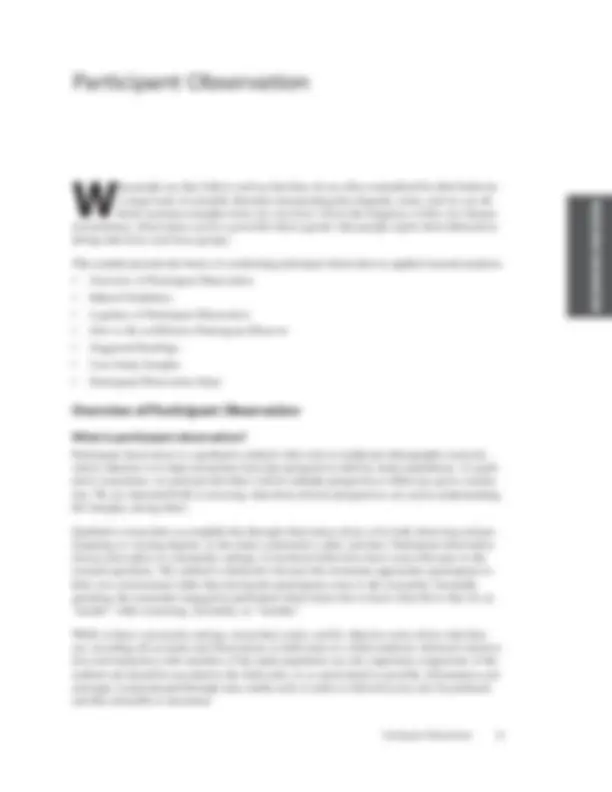
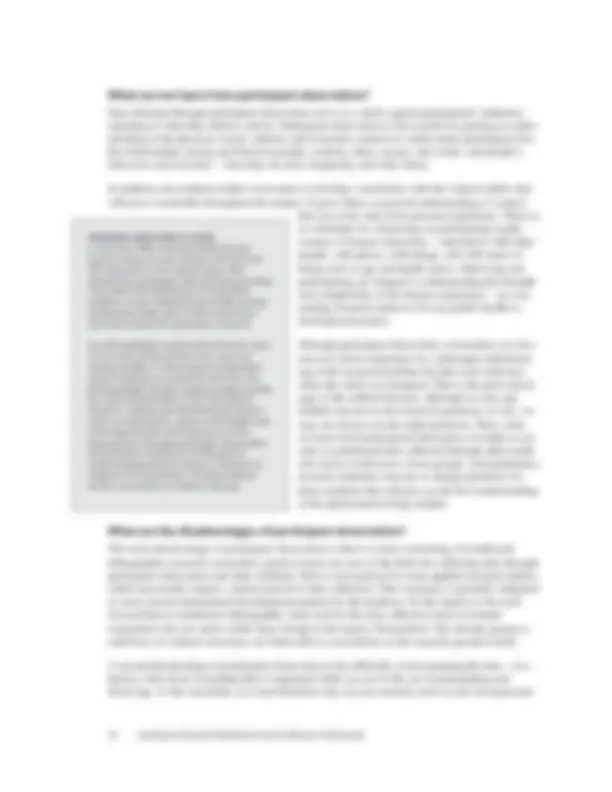
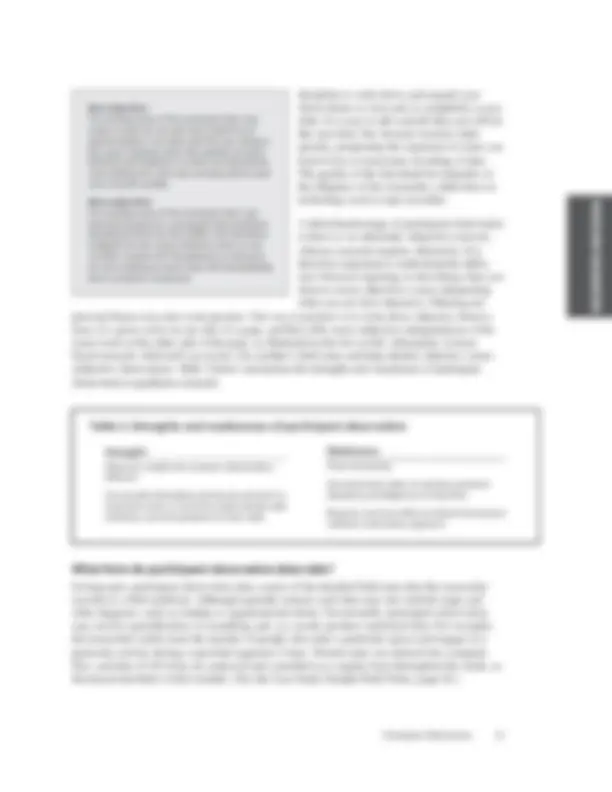
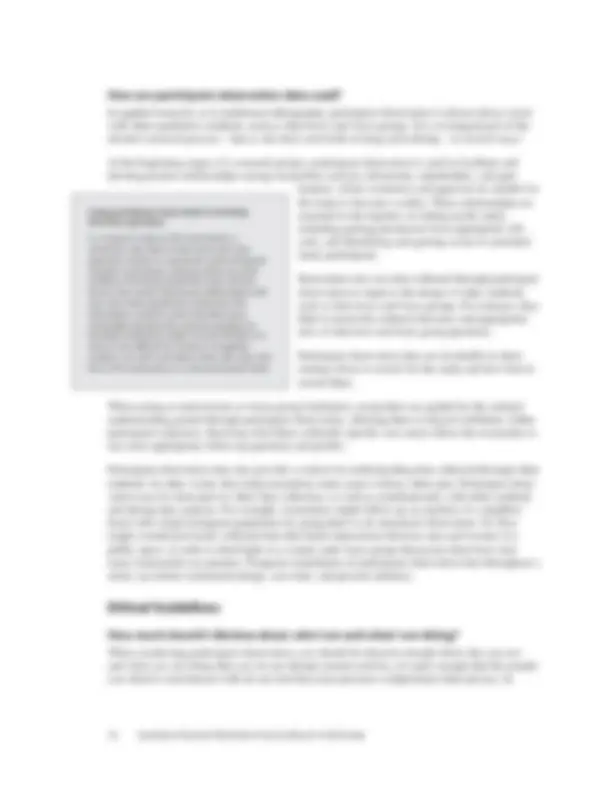

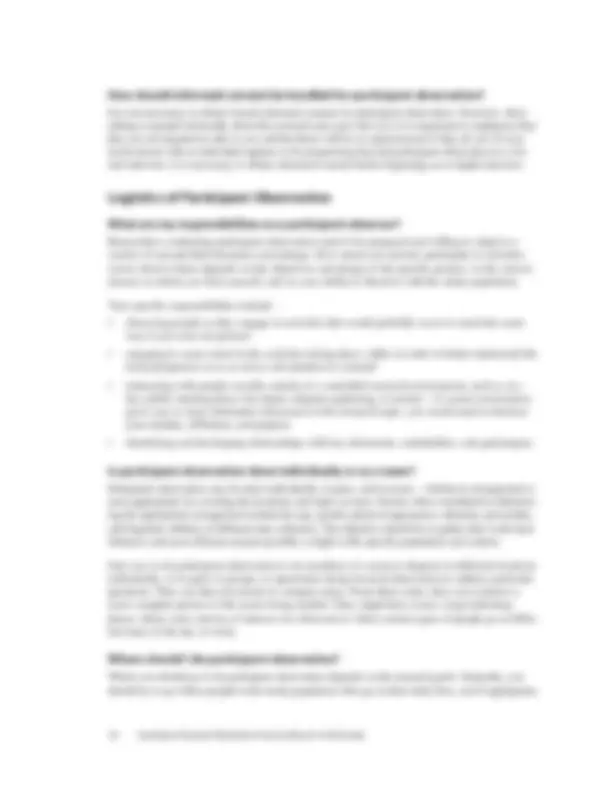

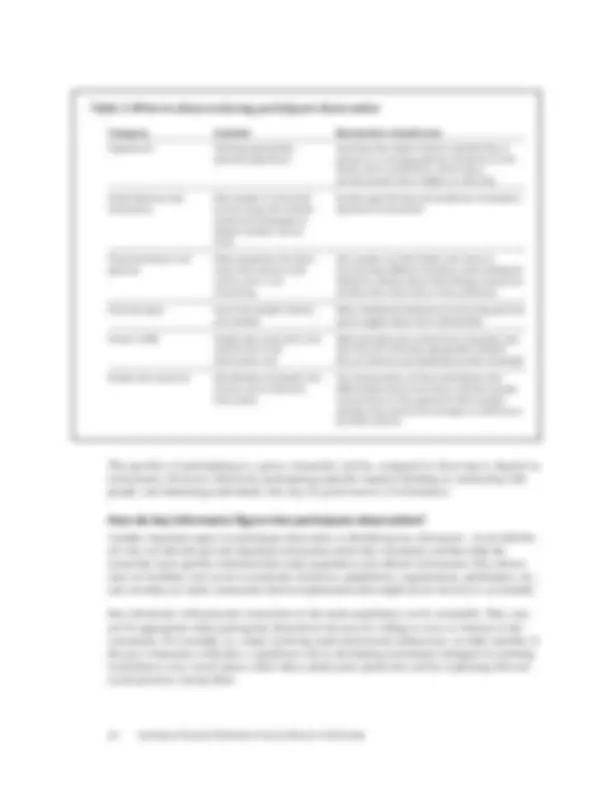

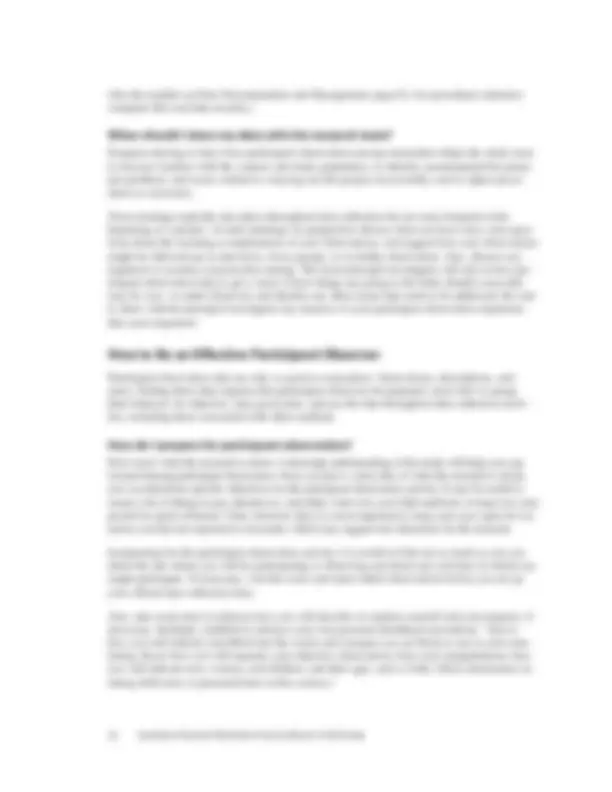

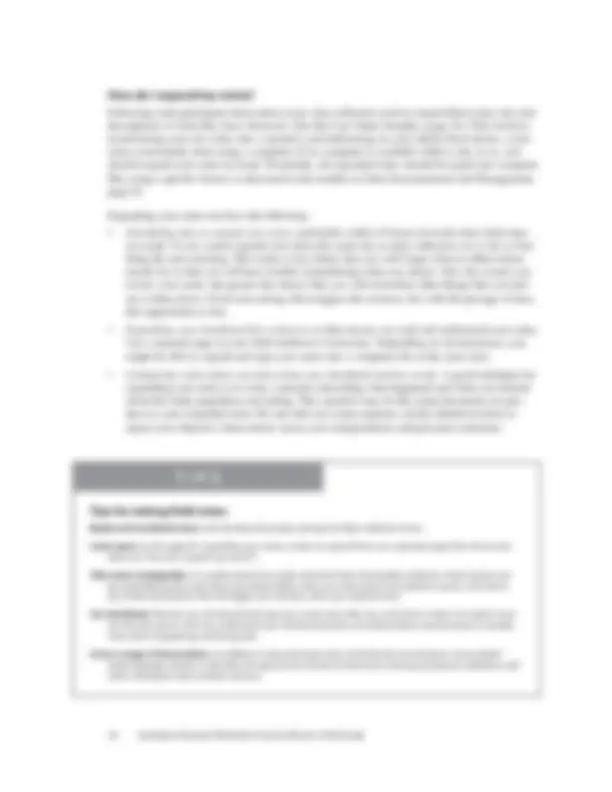





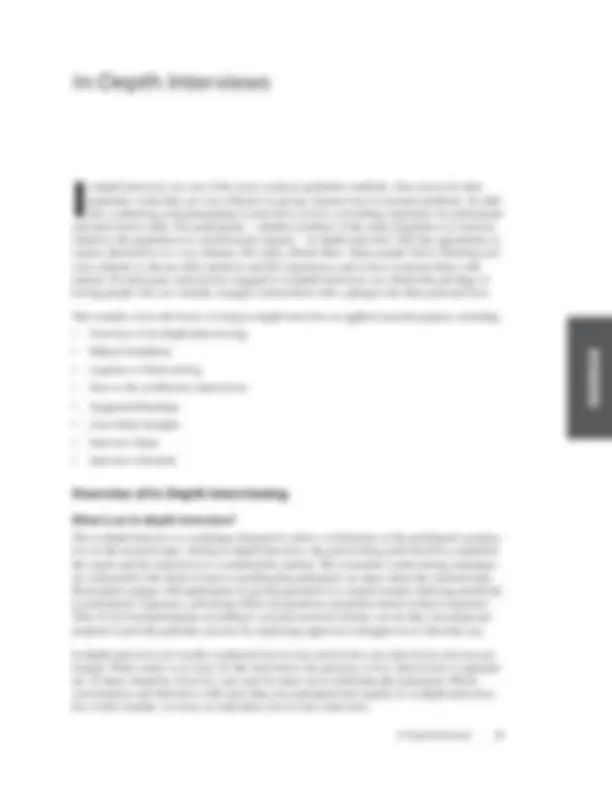
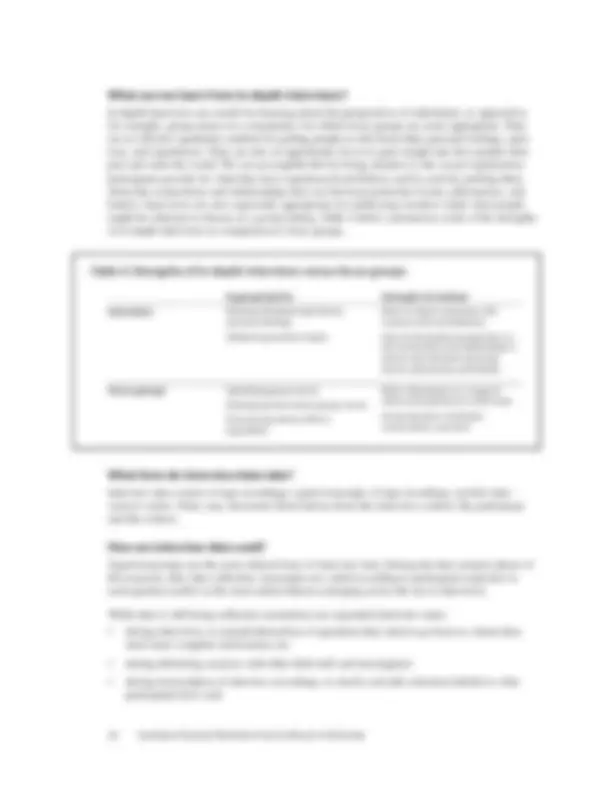
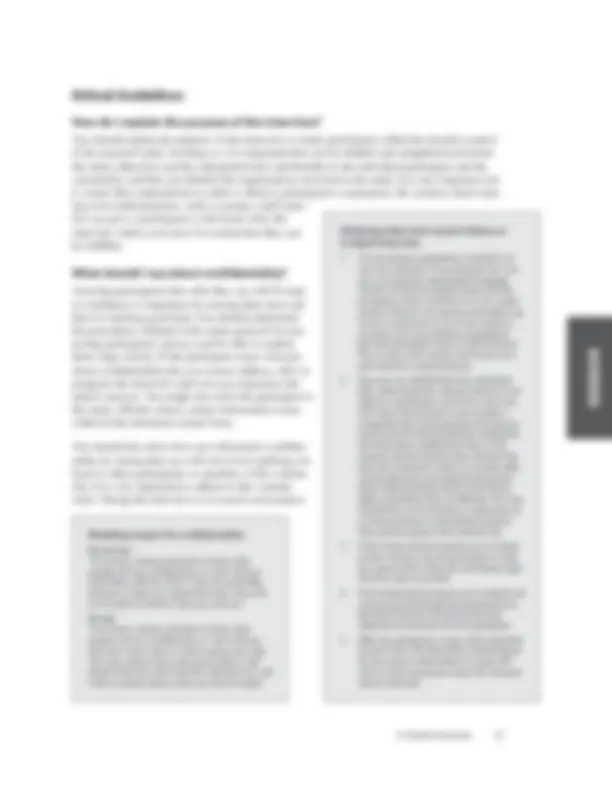
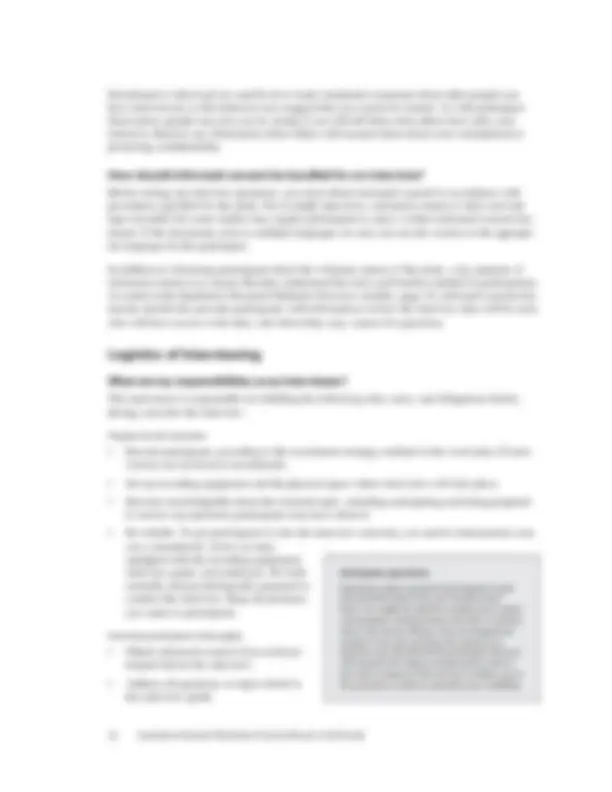
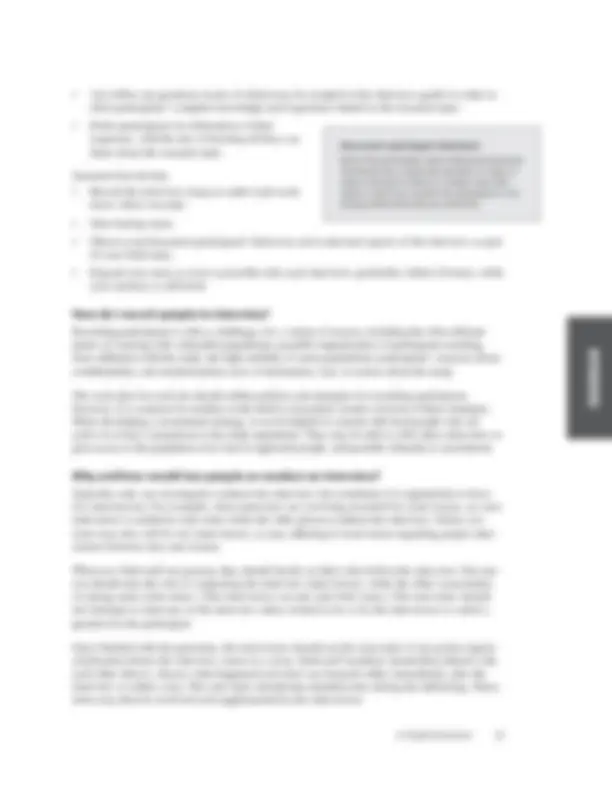
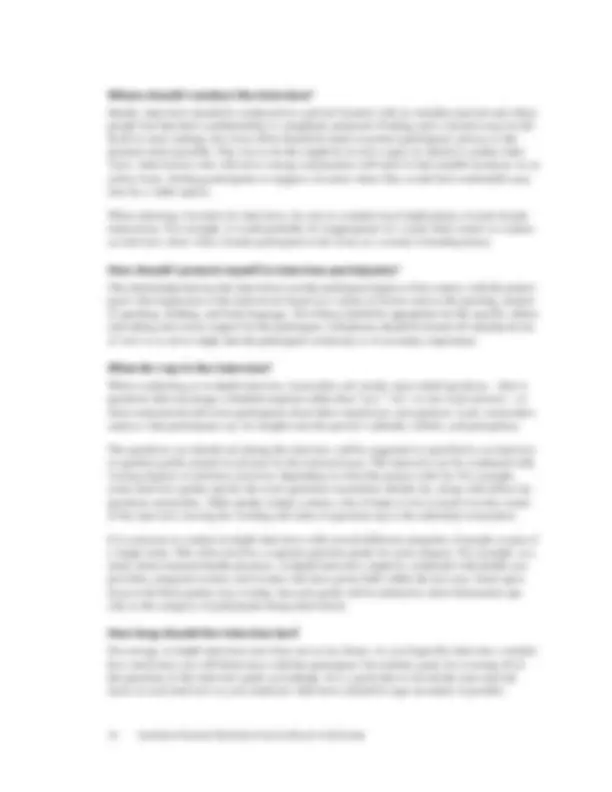



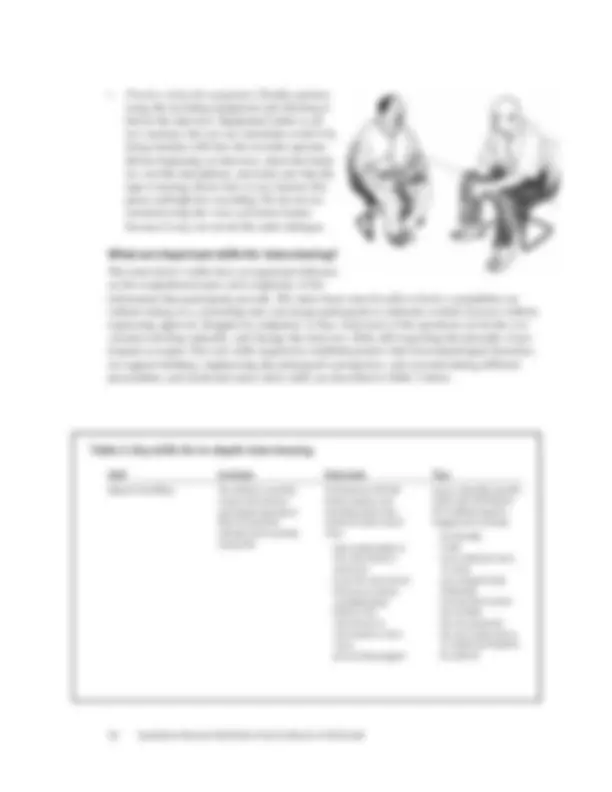

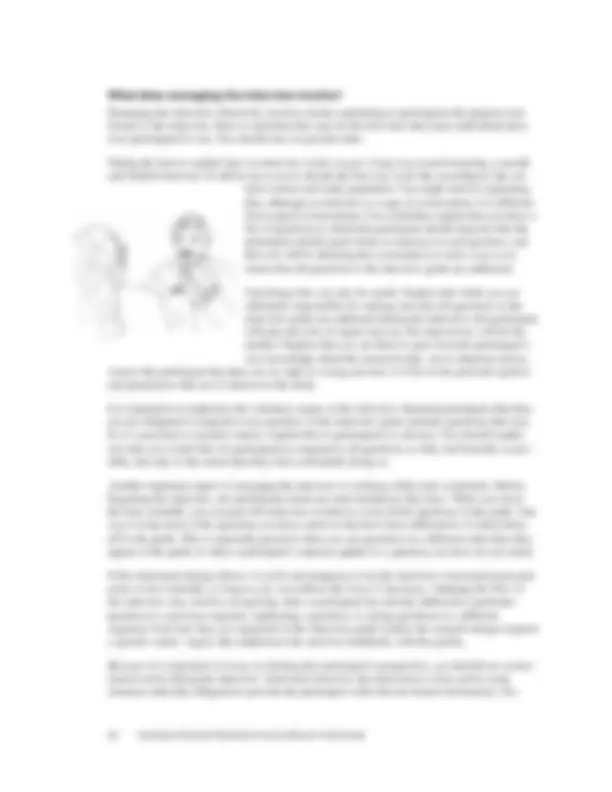

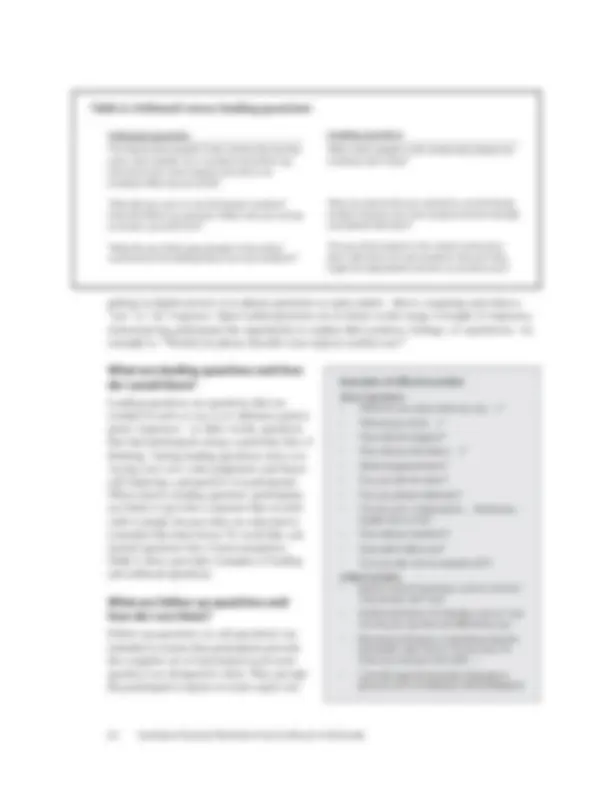

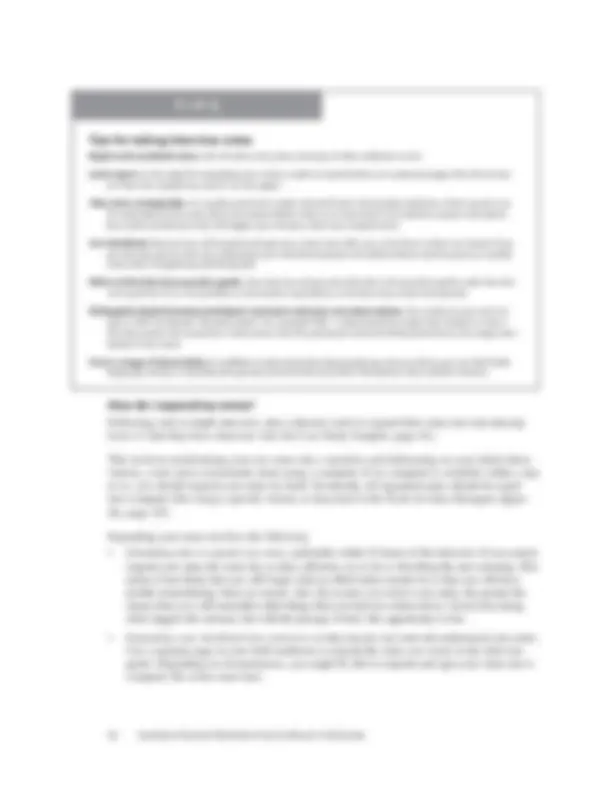








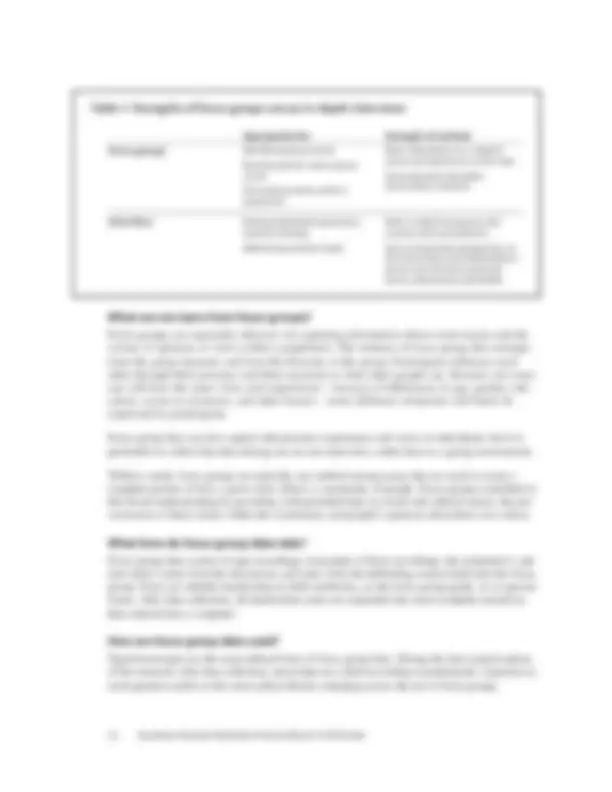

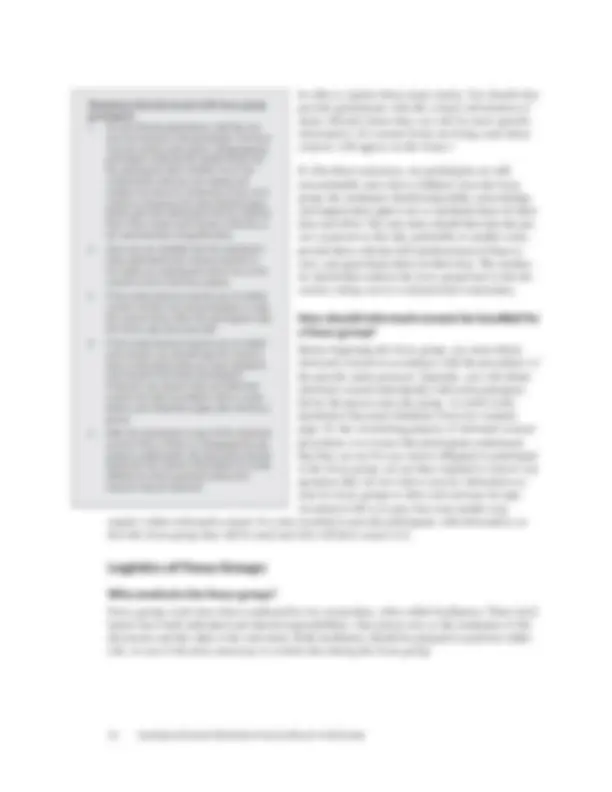
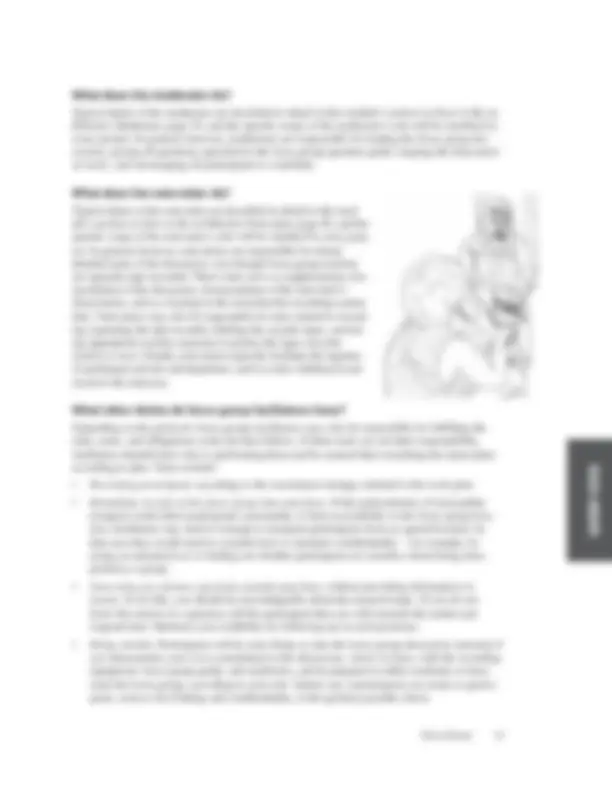
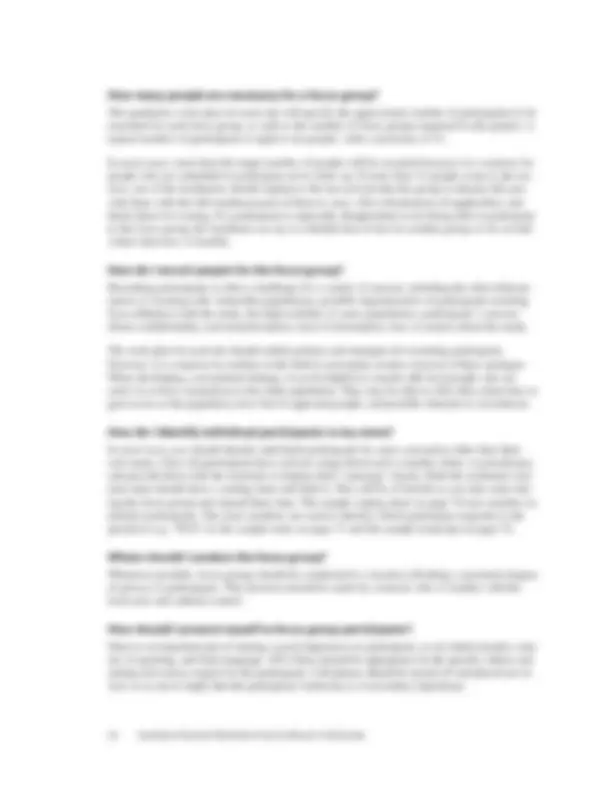

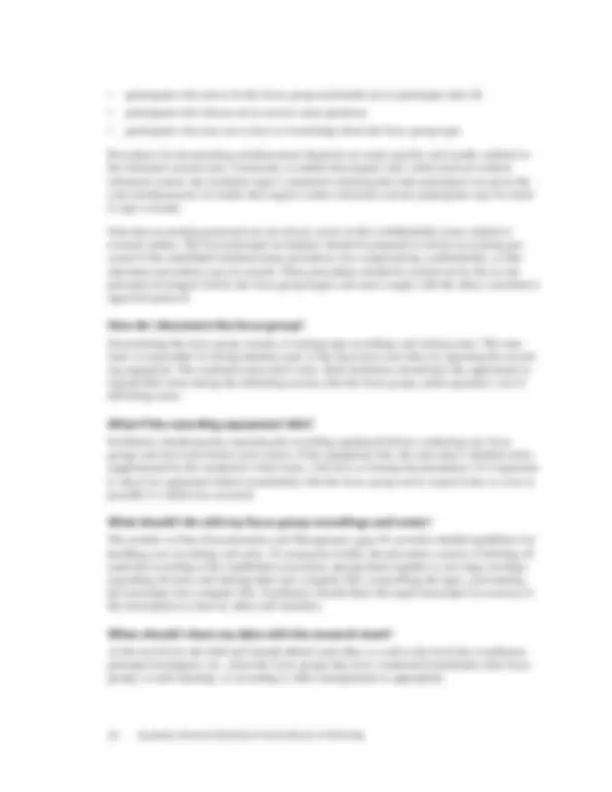

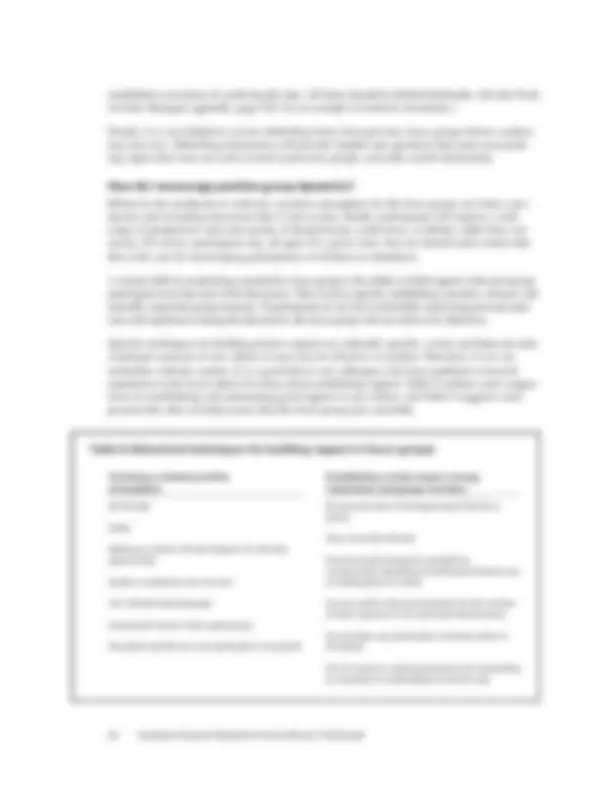



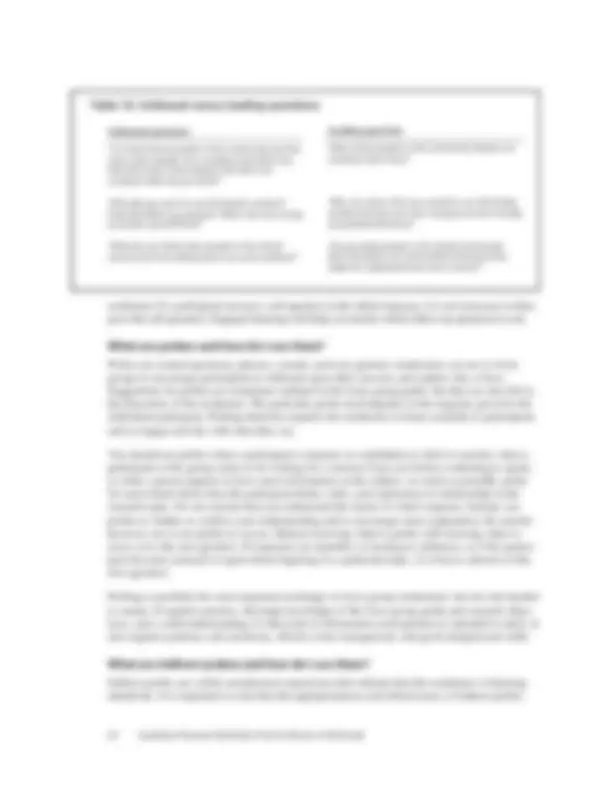

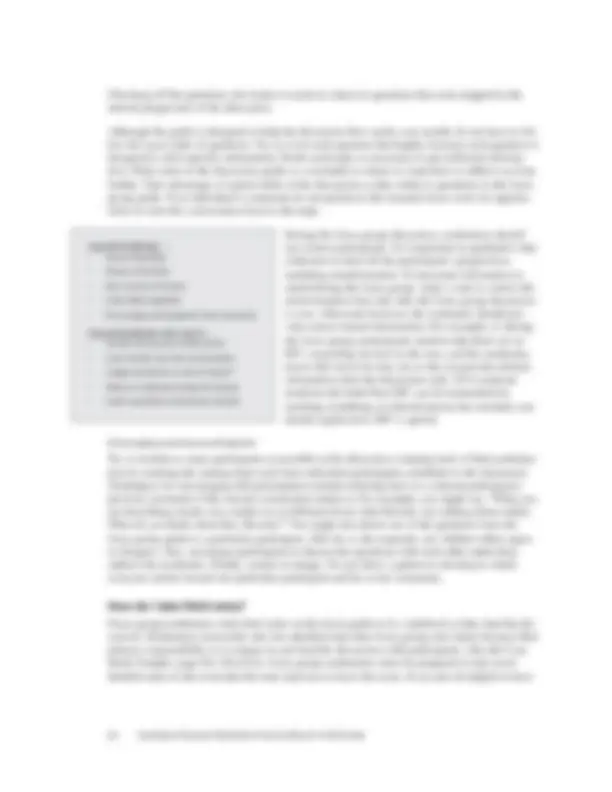



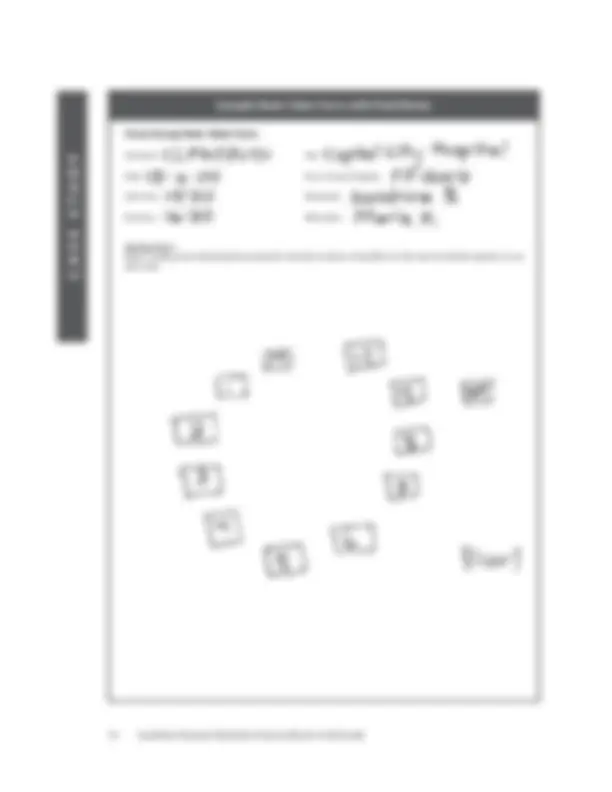

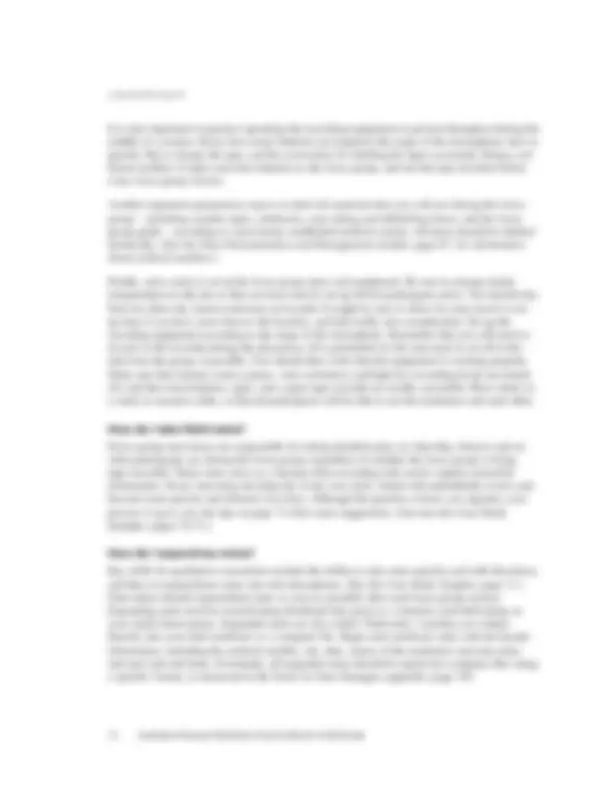

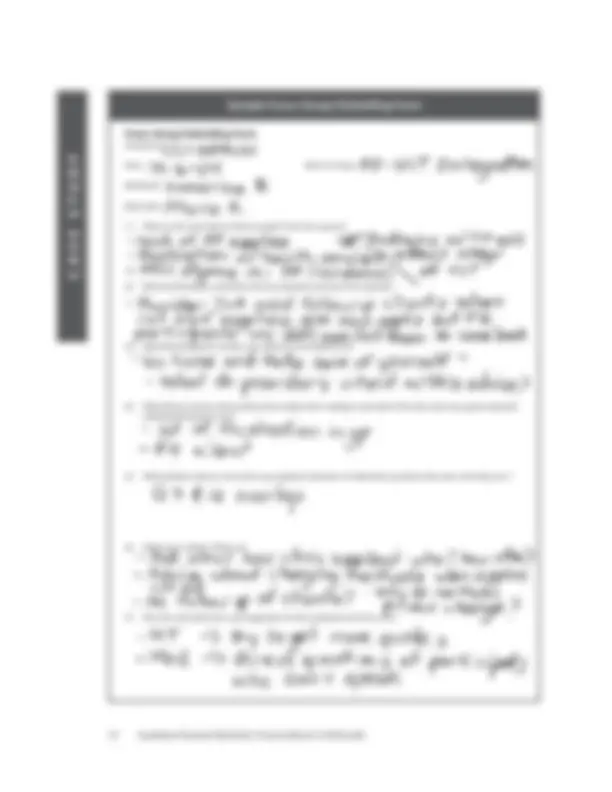



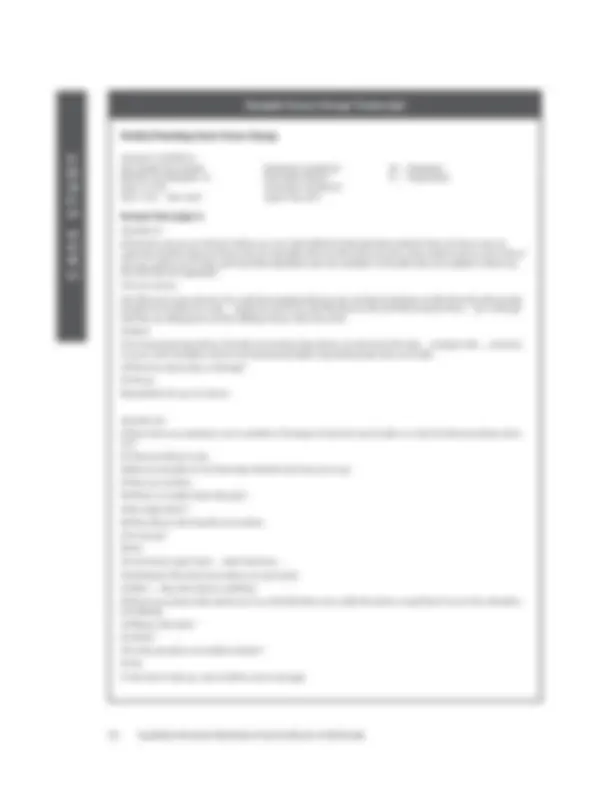





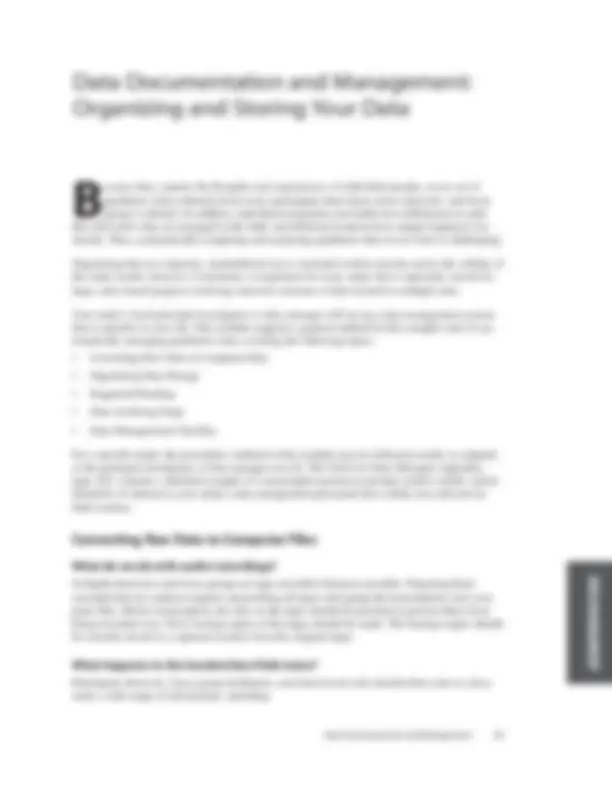
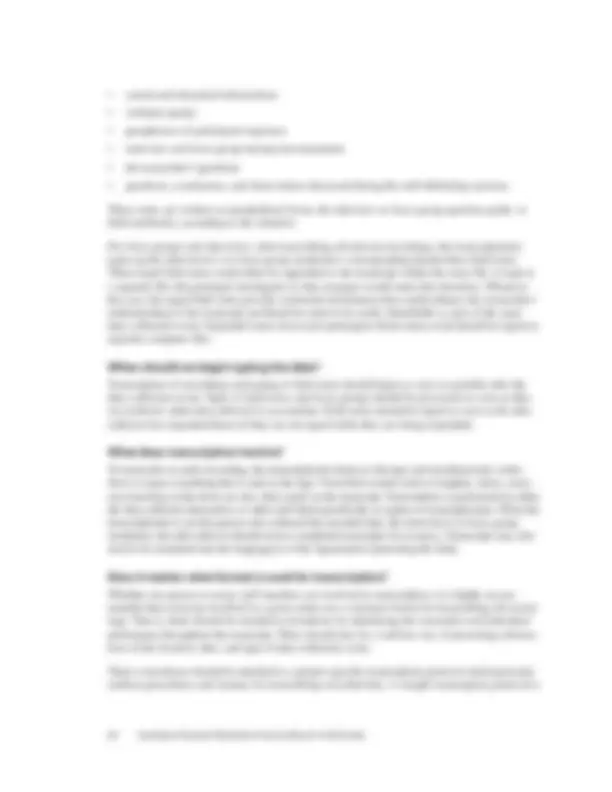



Study with the several resources on Docsity

Earn points by helping other students or get them with a premium plan


Prepare for your exams
Study with the several resources on Docsity

Earn points to download
Earn points by helping other students or get them with a premium plan
Community
Ask the community for help and clear up your study doubts
Discover the best universities in your country according to Docsity users
Free resources
Download our free guides on studying techniques, anxiety management strategies, and thesis advice from Docsity tutors
An overview of quantitative and qualitative research approaches, focusing on in-depth interviews and focus groups. It covers analytical objectives, question formats, data formats, flexibility in study design, and ethical considerations. The guide includes practical tips for conducting interviews and focus groups, such as recruitment strategies, interview checklists, and focus group checklists.
Typology: Lecture notes
1 / 137

This page cannot be seen from the preview
Don't miss anything!





























































































In July 2011, FHI became FHI 360.
FHI 360 is a nonprofit human development organization dedicated to improving lives in lasting ways by advancing integrated, locally driven solutions. Our staff includes experts in health, education, nutrition, environment, economic development, civil society, gender, youth, research and technology – creating a unique mix of capabilities to address today’s interrelated development challenges. FHI 360 serves more than 60 countries, all 50 U.S. states and all U.S. territories.
Visit us at www.fhi360.org.
Family Health International (FHI) is a nonprofit organization working to improve lives worldwide through research, education, and services in family health.
This publication was made possible through support provided by the U.S. Agency for International Development (USAID), under the terms of Cooperative Agreement No. CCP-A-00-95-00022-02. The opinions expressed herein are those of the authors and do not necessarily reflect the views of USAID.
Qualitative Research Methods: A Data Collector’s Field Guide © 2005 by Family Health International
Family Health International P.O. Box 13950 Research Triangle Park, North Carolina 27709 USA
http://www.fhi.org E-mail: publications@fhi.org
Acknowledgments v
Introduction vi
v
This field guide is the creation of all the authors. However, we especially recognize Cynthia Woodsong as its originator and inspiration. It is she who began crafting training materials during the course of her many public health projects in field sites far and wide, as she sought to prepare teams for the immediate while equipping them with skills to collect data for other research proj- ects in the future. During these training experiences, she perceived a recurring need to provide field teams with foundational, practical information on qualitative methods, presented in a form that was self-contained, tangible, and easy to consult during the action moments of data collec- tion. Dr. Woodsong built upon her repertoire of need-to-know training materials with each suc- ceeding project. In turn, these materials, many of which she developed with funding from the U.S. National Institutes of Health, have provided the bulk of the substance for the present field guide. Too, Dr. Woodsong’s vision for capacity building in developing country settings remains our collective vision for this field guide.
We would also like to recognize the conceptual contributions of Betsy Tolley and Lorie Broomhall. Their emphasis on the importance of allowing for individual approaches to preparing research teams for data collection served as a reminder that a practical field guide should not portend to be a training curriculum in and of itself. Rather than a replacement for hands-on interaction between trainers and data collection teams, we intend our guide to be a useful supplement for each team member as they learn and use qualitative methods in the field.
Reviewers Betty Akumatey of the University of Ghana, Legon, and Joy Noel Baumgartner of FHI merit our sincere thanks as well. Their candid evaluations helped us measure our goal of developing a functional tool against the reality of whether it worked in the field. We thank also Beth Robinson for her encouragement, enthusiasm, and technical and personal support from the start of this project to its finish. Thank you to Larry Severy for his all-round backing of the proj- ect. Merrill Wolf, editor, is due thanks for the manuscript’s organization and flow, as is Karen Dickerson, copyeditor and designer, for her great attention to detail and consistency. Illustrations are credited to Denise Todloski. Kerry McLoughlin graciously stepped in at a moment’s notice to provide assistance with the case study examples. And Lucy Harber, our gentle, smiling produc- tion manager, was indispensable in ways immeasurable for bringing the project to fruition.
This guide was made possible by funding from the U.S. Agency for International Development (USAID). We extend our gratitude for their unwavering support.
vi
Qualitative research methods are gaining in popularity outside the traditional academic social sciences, particularly in public health and international development research. Whereas quantitative research methods once dominated these fields, researchers have now begun drawing from a more diverse repertoire of methodologies as they tackle international public health problems. Qualitative methods have become important tools within this broader approach to applied research, in large part because they provide valuable insights into the local perspectives of study populations.
The great contribution of qualitative research is the culturally specific and contextually rich data it produces. Such data are proving critical in the design of comprehensive solutions to public health problems in developing countries, as scientists, medical doctors, pharmaceutical companies, and humanitarian organizations have come to recognize that biomedical solutions are only partial remedies. Rather, the success of a health intervention – that is, whether it actually reaches the peo- ple it is intended to help – rests also on how well it addresses sociobehavioral factors such as cul- tural norms, ethnic identities, gender norms, stigma, and socioeconomic status. Success measured on this basis has a bearing, in turn, on the cost-effectiveness, efficiency, and efficacy of interven- tions, concerns not insignificant in the eyes of project managers and funding agencies.
This field guide is based on an approach to doing team-based, collaborative qualitative research that has repeatedly proven successful in research projects sponsored by Family Health International (FHI) throughout the developing world. With its straightforward delivery of information on the main qualitative methods being used in public health research today, the guide speaks to the need for sim- ple yet effective instruction on how to do systematic and ethically sound qualitative research. The aim of the guide is thus practical. In bypassing extensive discussion on the theoretical underpinnings of qualitative research, it distinguishes itself as a how-to guide to be used in the field.
We have designed the guide as a tool for training the data collection staff members of multisite and team-based public health projects, but it easily has application for smaller-scale or multidisciplinary projects as well. It is also applicable to researchers spanning a wide range of expertise, from begin- ners to the more practiced – i.e., anyone wishing to learn or review the basics of qualitative data col- lection and management. We should point out, also, that even as our style of presenting the methods makes them accessible to people without an extensive background in qualitative research, we do not neglect important methodological nuances and details that can affect the quality of a project.
The motivation for this guide is our belief that focusing on the mechanics of systematic data col- lection and management will help to prepare data collectors well for the rigors and inevitable challenges of applied research in developing countries. In turn, well-trained data collectors will be better equipped to execute research protocols smoothly – to the extent that real-life circum- stances allow – and ultimately produce a data set of superior quality.
The guide is divided into five modules covering the following topics:
Module 1 – Qualitative Research Methods Overview Module 2 – Participant Observation Module 3 – In-Depth Interviews Module 4 – Focus Groups Module 5 – Data Documentation and Management
Qualitative Research Methods: A Data Collector’s Field Guide
viii Qualitative Research Methods: A Data Collector’s Field Guide
This case study will be used throughout the modules to illustrate the various ways qualitative research data may be recorded:
To assess the acceptability and feasibility of integrating HIV counseling and testing for non-pregnant women of reproductive age into existing family planning (FP) services in Capital City, Developing Country.
In Capital City, an estimated 12 percent of women of reproductive age (15 to 40) have HIV. This is only an estimate because both women and men in this country are generally disin- clined toward getting tested for HIV. This reluctance is due to social stigma and discrimina- tion associated with being HIV infected. They are particularly opposed to getting tested at the free clinic that was specifically set up for HIV/AIDS-related services five years ago. Rumors spread quickly in this community, and people who are seen entering or leaving the clinic are assumed to have HIV. For women this can be especially damaging, because their husbands or families may abandon them. Therefore, the services offered at the HIV facility, including antiretrovirals to help prevent mother-to-child transmission, are not being utilized.
In the 1980s, family planning carried heavy social stigma for women, but as a result of pub- lic information campaigns, community outreach, and health interventions, stigma and dis- crimination are no longer significant problems for women who wish to use family planning methods. The rate of contraceptive prevalence is 41 percent.
Social and behavioral changes are clearly needed in this community to reduce stigma and discrimination associated with HIV/AIDS, but such change can admittedly be slow to occur. In the meantime, there are free – but little-used – HIV services available that could reduce transmission rates from infected to non-infected adults and children, and increase the quality of life for people who are infected. Encouraging greater utilization of these serv- ices must necessarily start with increasing HIV counseling and testing among the general at-risk population. Antenatal clinics would be an appropriate place for interventions targeted at pregnant women. For women of reproductive age who are not pregnant, family planning clinics might offer an opportunity for discreet HIV counseling and testing because they are well utilized and have little associated stigma.
Therefore, in our study we will assess the acceptability and feasibility of integrating HIV counseling and testing for non-pregnant women into existing family planning services.
(1) Structured participant observation in 4 family planning clinics and the HIV/AIDS clinic.
(2) In-depth interviews with up to 10 family planning service providers, up to 5 providers and staff members from the HIV/AIDS clinic, up to 10 community leaders, and up to 10 women of reproductive age who use family planning but have not had HIV testing.
(3) Focus groups with 8 to 10 non-pregnant women of reproductive age who use family plan- ning and 8 to 10 non-pregnant women of reproductive age who do not use family planning.
C A S E
S T U D Y
Qualitative Research Methods: A Data Collector’s Field Guide
Module 1
Qualitative Research Methods Overview
2
issue may not be readily apparent. When used along with quantitative methods, qualitative research can help us to interpret and better understand the complex reality of a given situation and the implications of quantitative data.
Although findings from qualitative data can often be extended to people with characteristics sim- ilar to those in the study population, gaining a rich and complex understanding of a specific social context or phenomenon typically takes precedence over eliciting data that can be general- ized to other geographical areas or populations. In this sense, qualitative research differs slightly from scientific research in general.
The three most common qualitative methods, explained in detail in their respective modules, are participant observation, in-depth interviews, and focus groups. Each method is particularly suited for obtaining a specific type of data.
The types of data these three methods generate are field notes, audio (and sometimes video) recordings, and transcripts.
Quantitative and qualitative research methods differ primarily in:
Table 1, page 3, briefly outlines these major differences. For a more in-depth theoretical treat- ment of the differences between qualitative and quantitative research, we refer the reader to the suggested readings listed at the end of this chapter, especially Bernard 1995.
Qualitative Research Methods: A Data Collector’s Field Guide
3
The key difference between quantitative and qualitative methods is their flexibility. Generally, quantitative methods are fairly inflexible. With quantitative methods such as surveys and ques- tionnaires, for example, researchers ask all participants identical questions in the same order. The response categories from which participants may choose are “closed-ended” or fixed. The advan- tage of this inflexibility is that it allows for meaningful comparison of responses across partici- pants and study sites. However, it requires a thorough understanding of the important questions to ask, the best way to ask them, and the range of possible responses.
Overview
General framework
Analytical objectives
Question format
Data format
Flexibility in study design
Quantitative Seek to confirm hypotheses about phenomena
Instruments use more rigid style of eliciting and categorizing responses to questions
Use highly structured methods such as questionnaires, surveys, and structured observation
To quantify variation
To predict causal relationships
To describe characteristics of a population
Closed-ended
Numerical (obtained by assigning numerical values to responses)
Study design is stable from beginning to end
Participant responses do not influence or determine how and which questions researchers ask next
Study design is subject to statistical assumptions and conditions
Qualitative Seek to explore phenomena
Instruments use more flexible, iterative style of eliciting and categorizing responses to questions
Use semi-structured methods such as in-depth interviews, focus groups, and participant observation
To describe variation
To describe and explain relationships
To describe individual experiences
To describe group norms
Open-ended
Textual (obtained from audiotapes, videotapes, and field notes)
Some aspects of the study are flexible (for example, the addition, exclusion, or wording of particular interview questions)
Participant responses affect how and which questions researchers ask next
Study design is iterative, that is, data collection and research questions are adjusted according to what is learned
5
Even if it were possible, it is not necessary to collect data from everyone in a community in order to get valid findings. In qualitative research, only a sample (that is, a subset) of a popula- tion is selected for any given study. The study’s research objectives and the characteristics of the study population (such as size and diversity) determine which and how many people to select. In this section, we briefly describe three of the most common sampling methods used in qualitative research: purposive sampling, quota sampling, and snowball sampling. As data collectors, you will not be responsible for selecting the sampling method. The explanations below are meant to help you understand the reasons for using each method.
Purposive sampling, one of the most common sampling strategies, groups participants according to preselected criteria relevant to a particular research question (for example, HIV-positive women in Capital City). Sample sizes, which may or may not be fixed prior to data collection, depend on the resources and time available, as well as the study’s objectives. Purposive sample sizes are often determined on the basis of theoretical saturation (the point in data collection when new data no longer bring additional insights to the research questions). Purposive sampling is therefore most successful when data review and analysis are done in conjunction with data collection.
Quota sampling, sometimes considered a type of purposive sampling, is also common. In quota sampling, we decide while designing the study how many people with which characteristics to include as participants. Characteristics might include age, place of residence, gender, class, pro- fession, marital status, use of a particular contraceptive method, HIV status, etc. The criteria we choose allow us to focus on people we think would be most likely to experience, know about, or have insights into the research topic. Then we go into the community and – using recruitment strategies appropriate to the location, culture, and study population – find people who fit these criteria, until we meet the prescribed quotas. (See the section in this module on Recruitment in Qualitative Research, page 6.)
Purposive and quota sampling are similar in that they both seek to identify participants based on selected criteria. However, quota sampling is more specific with respect to sizes and proportions of subsamples, with subgroups chosen to reflect corresponding proportions in the population. If, for example, gender is a variable of interest in how people experience HIV infection, a quota sample would seek an equal balance of HIV-positive men and HIV-positive women in a given city, assuming a 1:1 gender ratio in the population. Studies employ purposive rather than quota sampling when the number of participants is more of a target than a steadfast requirement – that is, an approximate rather than a strict quota.
A third type of sampling, snowballing – also known as chain referral sampling – is considered a type of purposive sampling. In this method, participants or informants with whom contact has already been made use their social networks to refer the researcher to other people who could potentially
Overview
6
participate in or contribute to the study. Snowball sampling is often used to find and recruit “hidden populations,” that is, groups not easily accessible to researchers through other sampling strategies.
A recruitment strategy is a project-specific plan for identifying and enrolling people to partici- pate in a research study. The plan should specify criteria for screening potential participants, the number of people to be recruited, the location, and the approach to be used. In this section, we address some of the questions that may come up during the recruitment of participants.
Ideally, the local principal investigator and qualitative research team members work together, in close consultation with com- munity leaders and gatekeepers (that is, community members in positions of official or unofficial authority), to develop a plan to identify and recruit potential participants for each site. Recruitment strategies are determined by the type and number of data collection activities in the study and by the characteris- tics of the study population. They are typically flexible and can be modified if new topics, research questions, or subpopulations emerge as important to the study, or if initial strategies do not result in the desired number of recruits. The criteria for selec- tion can also be changed if certain data collection activities or subpopulations of people prove not to be useful in answering the research questions, as discussed in greater detail below.
It is important for the research team to be respectful of and responsive to the guidance and advice of local experts and community leaders. Remember that they have had more opportunity to establish rapport with the local community and they will also have to maintain that rapport after the study is complete. Remember also that community members may hold community lead- ers and local organizations accountable for any misunderstandings or other problems resulting from the behavior of the field staff.
Each research team develops guidelines for the introductory comments staff make to potential participants at each site. These guidelines need to be sensitive to the social and cultural contexts from which participants will be recruited. They should also reflect the researchers’ awareness that willingness to participate in an interview or focus group will depend on how well the partici- pants understand what the study is about, what will be expected of them if they participate, and how their privacy will be respected.
In developing recruitment guidelines, it is important to take special care to avoid saying anything that could be interpreted as coercive. The voluntary nature of participation in research studies should always be emphasized.
Qualitative Research Methods: A Data Collector’s Field Guide
8
This section briefly summarizes ethical issues relevant to qualitative research. It is intended to provide a context for discussion in subsequent modules of procedures for safeguarding research participants’ interests. Qualitative researchers, like anyone conducting research with people, should undergo formal research ethics training. The material presented here is not a substitute for training on research ethics. A list of ethics training resources is included on page 12.
Research ethics deals primarily with the interaction between researchers and the people they study. Professional ethics deals with additional issues such as collaborative relationships among researchers, mentoring relationships, intellectual property, fabrication of data, and plagiarism, among others. While we do not explicitly discuss professional ethics here, they are obviously as important for qualitative research as for any other endeavor. Most professional organizations, such as the American Anthropological Association, the Society for Applied Anthropology, the American Sociological Association, and the American Public Health Association, have developed broad statements of professional ethics that are easily accessible via the Internet.
The history and development of international research ethics guidance is strongly reflective of abuses and mistakes made in the course of biomedical research. This has led some qualitative researchers to conclude that their research is unlikely to benefit from such guidance or even that they are not at risk of perpetrating abuses or making mistakes of real consequence for the people they study. Conversely, biomedical and public health researchers who use qualitative approaches without having the benefit of formal training in the social sciences may attempt to rigidly enforce bioethics practices without considering whether they are appropriate for qualitative research.
Between these two extremes lies a balanced approach founded on established principles for ethical research that are appropriately interpreted for and applied to the qualitative research context. Agreed-upon standards for research ethics help ensure that as researchers we explicitly consider the needs and concerns of the people we study, that appropriate oversight for the conduct of research takes place, and that a basis for trust is established between researchers and study participants.
Whenever we conduct research on people, the well-being of research participants must be our top priority. The research question is always of secondary importance. This means that if a choice must be made between doing harm to a participant and doing harm to the research, it is the research that is sacrificed. Fortunately, choices of that magnitude rarely need to be made in qualitative research! But the principle must not be dismissed as irrelevant, or we can find our- selves making decisions that eventually bring us to the point where our work threatens to disrupt the lives of the people we are researching.
Qualitative Research Methods: A Data Collector’s Field Guide
9
Three core principles, originally articulated in The Belmont Report,^1 form the universally accepted basis for research ethics.
Respect for persons requires a commitment to ensuring the autonomy of research participants, and, where autonomy may be diminished, to protect people from exploitation of their vulnerabil- ity. The dignity of all research participants must be respected. Adherence to this principle ensures that people will not be used simply as a means to achieve research objectives.
Beneficence requires a commitment to minimizing the risks associated with research, including psychological and social risks, and maximizing the benefits that accrue to research participants. Researchers must articulate specific ways this will be achieved.
Justice requires a commitment to ensuring a fair distribution of the risks and benefits resulting from research. Those who take on the burdens of research participation should share in the bene- fits of the knowledge gained. Or, to put it another way, the people who are expected to benefit from the knowledge should be the ones who are asked to participate.
In addition to these established principles, some bioethicists have suggested that a fourth princi- ple, respect for communities , should be added. Respect for communities “confers on the researcher an obligation to respect the values and interests of the community in research and, wherever possible, to protect the community from harm.” 2 We believe that this principle is, in fact, fundamental for research when community-wide knowledge, values, and relationships are critical to research success and may in turn be affected by the research process or its outcomes.
Informed consent is a mechanism for ensuring that people understand what it means to partici- pate in a particular research study so they can decide in a conscious, deliberate way whether they want to participate. Informed consent is one of the most important tools for ensuring respect for persons during research.
Many people think of informed consent primarily as a form , that is, a piece of paper that describes in detail what the research is about, including the risks and benefits. This form gener- ally goes through ethics committee approval procedures, includes legalistic language, and is signed by the participant, the researcher, and possibly a witness. Such informed consent forms are appropriate for biomedical and other research – including qualitative – when the risks faced by participants may be substantial. They may also be necessary for minimal risk research when the foundation for trust between researchers and participants is weak.
Overview
(^1) National Commission for the Protection of Human Subjects of Biomedical and Behavioral Research. The Belmont Report. Ethical Principles and Guidelines for the Protection of Human Subjects of Research. Washington, DC: National Institutes of Health, 1979. Available: http://ohsr.od.nih.gov/guidelines/belmont.html.
(^2) Weijer C, Goldsand G, Emanuel EJ. Protecting communities in research: current guidelines and limits of extrapolation. Nature Genetics 1999;23(3):275-80.